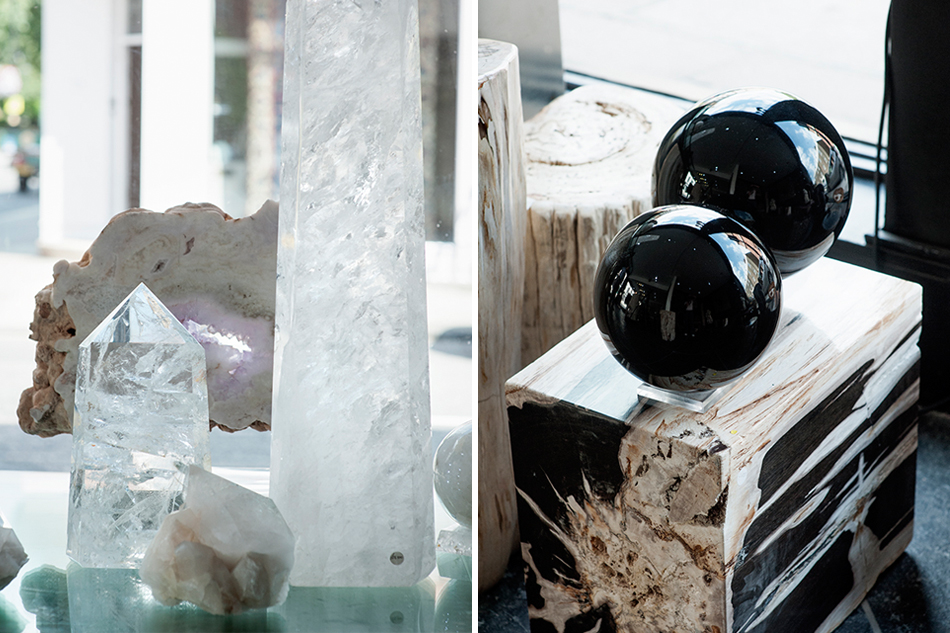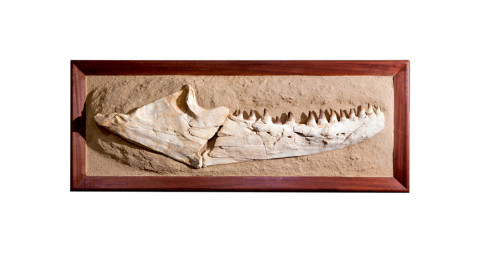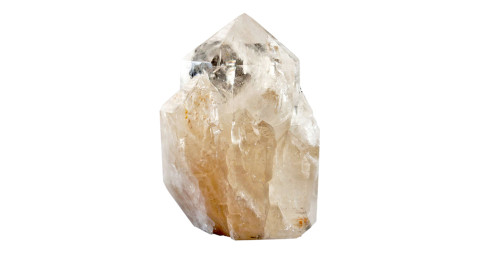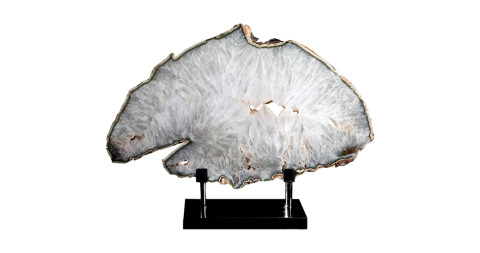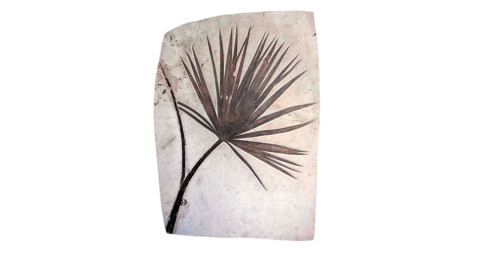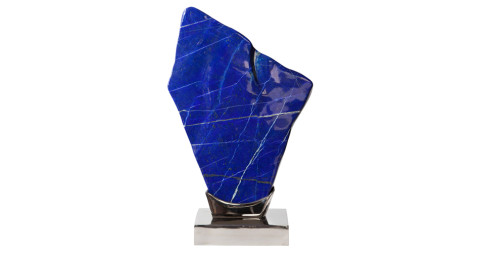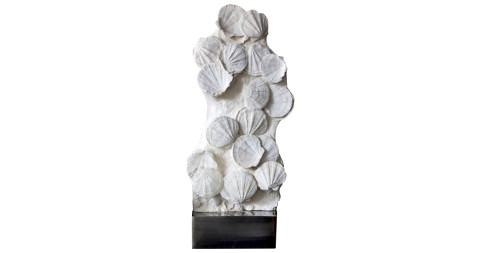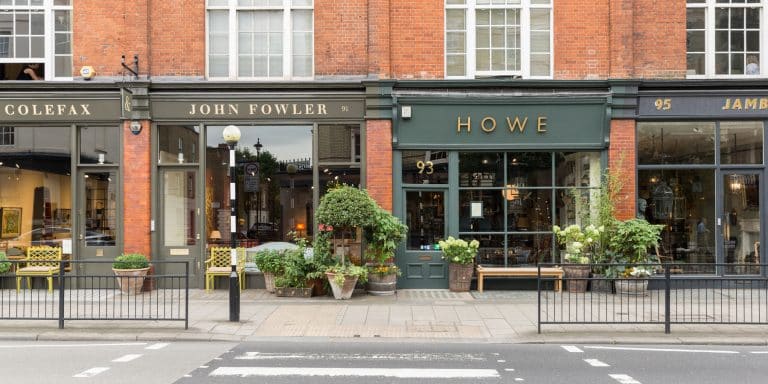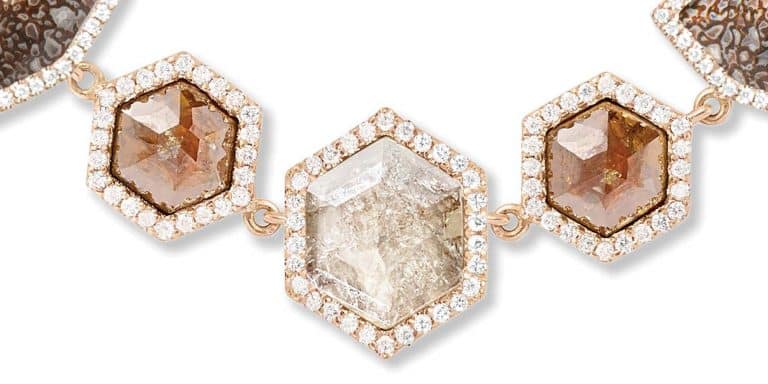
August 17, 2015Dale Rogers has been collecting and dealing in ancient objects for more than 30 years. In that time, he has scoured the globe in search of fossils, crystals and other naturally occurring treasures, assembling a world-class collection that has earned him an unparalleled reputation among collectors and interior designers. Photo by Barry Macdonald. Top: An 80 million-year-old iridescent ammonite
Dale Rogers was 24 years old and sitting in a café-cum-antiques emporium in Morocco, smoking something designed to improve the mood, when he noticed that the black stone tabletop in front of him was embedded with strange white striations. When he looked more closely, he saw these were sea creatures, immaculately fossilized in their shells, and that each one was slightly different. It was love at first sight (and not a hallucination): Rogers, who had no prior interest in geology or natural history and had already tried dozens of jobs, bought a handful of the fossils “for nothing” and proceeded to travel around the country in search of their source. “In those days, there was very little of that material around, and nobody seemed to know exactly where it came from,” Rogers says. He was determined to find out.
Some 30 years later, the London-based Rogers — an imposingly tall man with the rough-diamond air of an adventurer — is the proprietor of what must be one of the most extraordinary shops in the world. Dale Rogers Ammonite is filled with museum-quality ammonites, the name for a group of squidlike predators that lived inside coiled shells 65 to 240 million years ago and ranged in size from hand-held tiny to nearly seven feet across. In the store, huge displays of the intricately swirling shells are piled against one another; dazzling chunks of lapus lazuli, rose quartz and citrine are mounted like contemporary sculptures; tapering columns of amethyst stretch to the ceiling; dinosaur skulls and whale jaws hang overhead; and fossilized skeletons of reptiles and fish — so delicately pressed into rock that they look like the finest of etchings — are mounted on the walls.

From left: A mounted green malachite and chrysocolla specimen, black quartz cluster from Brazil, mounted pyrite and hematite specimen from Kosovo, and freestanding quartz crystal
Designers and collectors seek out these finds for their rarity and their beauty; Rogers has several can’t-be-named high-profile clients who have homes all over the world filled with his treasures. Showstopping finds notwithstanding, he is equally passionate about a fragment of meteorite or a petrified tree trunk. “Bonkers” is his favorite expression, and, as far as he is concerned, the more bonkers a piece — the harder its route back from the mountains of Afghanistan or an ancient ocean crevice, the more improbable its passage to his shop on the high-end designer-occupied Pimlico Road in London’s Chelsea — the better.
Here, Rogers talks to Introspective about his love of the hunt, the most unusual piece he has come across and why fossils are the most fascinating objects for interiors.
How did you know what to look for when you first started fossil hunting?
I learned by being obsessive. I couldn’t stop thinking about those first fossils I saw in Morocco. I kept wondering if they came from a solid mass and if you could cut them. I was more or less unemployed back in Britain, and I read as much as I could, scraped together some money and flew back to Tangiers. I got friendly with a Moroccan guy and persuaded him to travel south into the Sahara with me to translate. It took about 18 months to really get to the source of the black and white fossils, a tiny place called Tazzarine close to the Algerian border. It was only accessible on a dirt track, and we ruined the car, but we found a cliff face that was the source. We eventually were able to enlist the locals to drag the stuff out.

“I’ve always had the idea of fossils as interior objects — they are endlessly fascinating to look at — and I wanted to have a gallery, a place to display everything I was collecting,” says Rogers of his decision to open shop in 2006 at the gallery’s current location on London’s Pimlico Road.
It sounds like the chase is a big part of the fun for you.
Yes. I made no money from that first lot of fossils I found, but it was never about the money. I just loved the stuff — although no one else seemed to share my enthusiasm then. I must have cold-called 1,000 interior designers and architects in London, on foot, holding two slabs under my arms. I think I got one sale, from Andrew Martin, who went, “Wow, I’ll have four of those please.” I was about to give up, but that rekindled my enthusiasm and I went back to Morocco and brought back other things.
I loved the travel and the excitement, but it was the ’80s. There was an economic crisis, and suddenly people who were buying things from me went bust. I went bust, too. I had my house repossessed and opened a miniscule stall on Portobello Road. That allowed me to discover English fossils in places like Whitby, Dorset, the Isle of Wight, Somerset. I had a regular income on weekends and would spend the weekdays traveling around looking for fossils. I saw a whole new dimension in them and started learning about anything connected to stones and semi-precious stones, too.
What is the most unusual object you have ever handled?
Blimey. I suppose it must be the Medusa, a two-ton piece that is a densely packed combination of different species of ammonite. The chap who discovered it, Luc Ebbo, had found and restored one on a smaller scale. I had seen a photograph and said, “Oh, my God, can you do another?” He said not a hope in hell. But I goaded him, and eventually he found another that was in the Atlas Mountains in North Africa. It had to come down on camels and be restored, which took four years.

From left: Amethyst geode with quartz point from Urugay, mounted citrine from Brazil
What made you believe that there was an interior design market for all of this? Are your clients mostly designers or private individuals?
I’ve always had the idea of fossils as interior objects — they are endlessly fascinating to look at — and I wanted to have a gallery, a place to display everything I was collecting. When this space came up in 2006, I took a deep breath and chucked every bit of money I had at it. I’m not really a businessman. Getting the best of the best is my philosophy, and building relationships. I have spent a lot of time hanging out with the miners and the gypsies and the quarrymen, and in the end that’s how you find things and sustain a supply chain. When you sell something, you can feel like you are selling a bit of your heart because it takes so much effort to get it and each piece has a story.
About fifty percent of my clients are interior designers. We work quite a lot with the super-yacht designers, especially Terence Disdale, who has designed Roman Abramovich’s boats. The best ones built over the last ten years have wonderful pieces from us. It is simply the nautical link between many of the marine fossils and the yachts themselves. The nautical link extends to coastal properties, restaurants and yacht clubs.
There are some private collectors who like to remain anonymous. We have one amazing client in Thailand who has been filling his own museum with petrified wood. It’s bonkers. But we also want to cater to clients who want to spend a few hundred dollars. We like people to come in and browse, and we don’t want them to feel intimidated.
TALKING POINTS
Dale Rogers shares his thoughts on a few choice pieces

